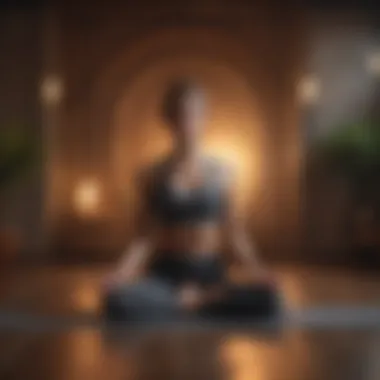Tranquilyx: Mastering the Art of Relaxation and Mental Well-Being


Understanding Mindfulness
Mindfulness, in essence, is the practice of being present in the moment without judgment. It entails focusing on sensations, thoughts, and emotions as they arise. The benefits of mindfulness are profound, ranging from reduced stress and anxiety levels to improved overall well-being. In our fast-paced modern world, where distractions abound, cultivating mindfulness is a valuable skill. By incorporating mindfulness into daily life, individuals can experience increased clarity, focus, and emotional resilience. Learning various practices and techniques for cultivating mindfulness is essential for continued growth in this area.
Guided Meditation Sessions
Embarking on guided meditation sessions can revolutionize one's approach to inner peace and self-awareness. With various types of guided meditations available, individuals can choose what resonates with them most – whether it be body scans, loving-kindness, or breath awareness. Starting a guided meditation practice is as simple as finding a quiet space, sitting or lying down comfortably, and following the voice or a set of instructions. To enhance the meditation experience, it is advisable to wear loose clothing, dim the lights, and use props like cushions or blankets for added comfort.
Managing Stress and Anxiety
The insidious effects of modern life's stressors can take a toll on mental well-being, manifesting as stress and anxiety. Understanding the causes and effects of stress and anxiety is crucial in learning how to combat them effectively. Mindfulness techniques, such as deep breathing exercises, body scans, and progressive muscle relaxation, can aid in reducing stress and anxiety levels. Additionally, coping strategies like journaling, physical exercise, and connecting with supportive friends or professionals can provide much-needed relief during overwhelming moments.
Improving Sleep Quality
Quality sleep is a cornerstone of overall well-being, yet the stresses of daily life can often disrupt restful slumber. Engaging in guided nighttime meditations specifically designed to induce relaxation and ease the mind can be an effective remedy. Furthermore, creating a calming bedtime routine – free from electronic devices, screens, and stimulants – can signal to the body and mind that it is time to wind down for the night.
Enhancing Mindfulness at Work
In the bustling environment of the workplace, integrating mindfulness practices can significantly boost productivity and efficiency. Being mindful at work involves focusing on tasks at hand, managing distractions, and taking short breaks to reset the mind. By implementing techniques such as breath awareness, mini-mindful moments, and grounding exercises, individuals can navigate work-related stress with greater ease and composure.
Understanding Relaxation
In the realm of holistic well-being, Understanding Relaxation stands as a cornerstone for achieving optimal mental health. This section delves into the intricacies of how relaxation techniques can transform not only one's mindset but also their overall quality of life. By unraveling the essential elements of relaxation, readers can grasp the significance of incorporating these practices into their daily routine. Understanding Relaxation goes beyond mere relaxation; it is a profound journey towards inner peace and mental clarity.
Importance of Relaxation
Effects on Mental Health
Exploring the Effects on Mental Health unveils a crucial aspect of relaxation techniques. The impact of relaxation on mental health is profound, with studies indicating a direct correlation between relaxation practices and improved psychological well-being. By delving into this aspect, individuals can harness the power of relaxation to mitigate stress, anxiety, and depression. Understanding how relaxation influences mental health is paramount in crafting a well-rounded approach to self-care and emotional resilience.
Enhanced Well-being
Enhanced Well-being represents the pinnacle of relaxation's benefits. By delving into this subsection, readers can grasp how relaxation transcends mere stress relief to foster a holistic sense of well-being. The profound impact of relaxation on overall wellness highlights its importance as a cornerstone of self-care practices. By understanding how relaxation enhances well-being, individuals can unlock the potential for sustained happiness and emotional balance in their lives.
Science Behind Relaxation
Neurological Impact
The Neurological Impact of relaxation techniques is a fascinating area of study. By examining how relaxation affects the brain and nervous system, readers can uncover the intricate mechanisms that drive a sense of calm and tranquility. Understanding the neurological underpinnings of relaxation provides insight into its efficacy in promoting mental clarity and emotional balance. By delving into this aspect, individuals can appreciate the scientific basis for the transformative power of relaxation.
Stress Response
The Stress Response elucidates how relaxation serves as a potent tool in modulating the body's physiological response to stress. By exploring this facet, readers can grasp how relaxation techniques effectively counter the detrimental effects of chronic stress on the body and mind. Understanding the nuances of stress response equips individuals with the knowledge to combat stress-related ailments and cultivate a resilient mindset. By delving into this topic, readers can harness relaxation as a formidable ally in navigating life's challenges.
Psychological Benefits


Emotional Regulation
Emotional Regulation emerges as a core psychological benefit of relaxation practices. By dissecting this aspect, individuals can comprehend how relaxation techniques foster emotional resilience and inner calm. The ability to regulate one's emotions effectively is crucial for mental well-being and interpersonal relationships. By exploring emotional regulation in the context of relaxation, readers can cultivate a profound sense of self-awareness and emotional intelligence.
Cognitive Clarity
Cognitive Clarity encapsulates the cognitive benefits of relaxation, offering readers an insight into how relaxation techniques enhance mental acuity and focus. By delving into this aspect, individuals can grasp the profound impact of relaxation on cognitive functioning and decision-making. The clarity of thought and heightened cognitive abilities resulting from relaxation underscore its significance in promoting mental clarity and executive function. By understanding the cognitive benefits of relaxation, individuals can harness its transformative power in optimizing their cognitive performance and overall well-being.
Practical Techniques
In the realm of mastering the art of relaxation, Practical Techniques play a pivotal role. These techniques serve as actionable tools for individuals seeking to enhance their mental well-being through practical applications of mindfulness practices. Practical Techniques encompass a variety of methods, ranging from mindfulness meditation to stress relief strategies, that are essential for achieving a state of tranquility in the hustle and bustle of daily life. Understanding and implementing these techniques can significantly impact one's ability to manage stress, improve focus, and promote holistic well-being. It is imperative to delve into the specifics of each technique to grasp their benefits fully.
Mindfulness Meditation
Mindfulness Meditation stands at the core of relaxation practices, offering profound benefits for mental well-being. Within this practice, two fundamental aspects, namely Body Scan and Focused Breathing, take center stage.
Body Scan
The Body Scan technique involves a systematic focus on different parts of the body, aiming to bring awareness and relaxation to each area. This method contributes by fostering a deep connection between the mind and body, allowing for the release of tension and stress accumulated throughout the day. Body Scan is widely recognized for its ability to promote relaxation, enhance self-awareness, and alleviate physical discomfort, making it a popular choice in the realm of mindfulness practices. While Body Scan offers unparalleled benefits, individuals may find it time-consuming in their busy schedules, necessitating a commitment to regular practice to reap its rewards.
Focused Breathing
Focused Breathing revolves around the conscious regulation of breathing patterns to induce a sense of calm and focus. This technique is known for its simplicity and effectiveness in reducing anxiety, improving concentration, and promoting relaxation. Focused Breathing serves as a versatile tool that can be practiced anywhere, making it a practical choice for individuals seeking quick yet impactful methods to alleviate stress. However, it requires discipline and concentration to harness its full potential, underscoring the importance of consistent practice for optimal results.
Progressive Muscle Relaxation
Progressive Muscle Relaxation stands as another key practical technique in the journey towards relaxation mastery. Comprising two essential components, Technique Overview and Implementation Tips, this method offers a structured approach to releasing muscular tension and promoting overall relaxation.
Technique Overview
The Technique Overview entails a systematic process of tensing and releasing muscle groups to relieve physical stress and induce relaxation. By sequentially targeting different muscle groups, individuals can cultivate a heightened awareness of bodily sensations, reduce muscular tightness, and unwind deeply. This technique's straightforward approach and immediate effects make it a preferred choice for individuals seeking a tangible method to unwind physically and mentally. However, it's vital to practice proper form and pacing to prevent muscle strain and maximize the benefits of this technique.
Implementation Tips
Incorporating Implementation Tips is crucial for optimizing the Progressive Muscle Relaxation technique. These tips provide practical guidance on enhancing the efficacy of muscle relaxation exercises by incorporating proper breathing techniques, creating a conducive environment, and setting aside dedicated time for practice. Implementation Tips serve as a support system for individuals embarking on their relaxation journey, offering insights to refine their practice and ensure sustainable results. Yet, maintaining consistency and adapting the tips to personal preferences are essential for long-term success in mastering muscle relaxation.
Visualization Exercises
Visualization Exercises offer a creative outlet for relaxation seekers, stimulating the mind and senses to foster inner calm and clarity. Within this technique, Nature Imagery and Journey Exploration emerge as immersive pathways to enhance mental well-being through imaginative visualization.
Nature Imagery
Nature Imagery entails visualizing natural landscapes, such as lush forests, tranquil lakes, or vast meadows, to evoke a sense of peace and serenity. This technique harnesses the restorative power of nature to promote relaxation, reduce psychological distress, and heighten emotional well-being. Nature Imagery's ability to transport individuals to idyllic settings aids in stress reduction and mental rejuvenation, making it a favored choice for those seeking solace in the midst of urban chaos. Nevertheless, individuals must maintain focus and clarity in their visualization to derive optimal benefits and immerse themselves fully in this tranquil experience.
Journey Exploration
Journey Exploration delves into the realm of the subconscious, inviting individuals to embark on mental journeys of self-discovery and introspection. This exercise involves visualizing oneself in various scenarios or narratives, exploring unknown terrains of the mind to uncover hidden emotions and insights. Journey Exploration offers a profound avenue for personal growth, emotional healing, and creative expression, making it a versatile tool for individuals seeking deeper relaxation and self-awareness. While this technique encourages imaginative exploration, individuals should approach it with an open mind and willingness to delve into the depths of their consciousness to unlock its transformative potential.


Incorporating Relaxation into Daily Life
In the realm of mastering relaxation, the section titled 'Incorporating Relaxation into Daily Life' holds paramount significance. This segment delves into how individuals can seamlessly integrate relaxation practices into their daily routines, thereby reaping manifold benefits for their overall well-being. By emphasizing the importance of incorporating relaxation techniques into daily life, individuals can establish a foundation for sustained mental clarity and emotional equilibrium. This article meticulously explores the specific elements, benefits, and considerations surrounding the incorporation of relaxation practices into daily life, offering actionable insights for readers aspiring to enhance their mindfulness and tranquility levels.
Creating a Relaxation Routine
Setting Intentions
Within the broader context of relaxation routines, setting intentions emerges as a pivotal component that drives success and consistency in one's mindfulness journey. The act of setting intentions involves consciously outlining specific objectives or goals for each relaxation session, empowering individuals to focus their energy and attention with purpose. This deliberate approach not only enhances the efficacy of relaxation techniques but also cultivates a deeper sense of mindfulness and self-awareness. In the context of this article, setting intentions serves as a cornerstone for readers to personalize their relaxation practices, tailoring them to align with their unique needs and aspirations. The characteristic adaptability of setting intentions makes it a versatile and popular choice for individuals seeking to harness the full benefits of relaxation within their daily lives.
Consistency
Another fundamental aspect of cultivating a sustainable relaxation routine is the virtue of consistency. By committing to regular practice and maintaining a structured schedule, individuals can solidify their relaxation habits and facilitate long-term well-being benefits. Consistency serves as a guiding principle that anchors individuals in their mindfulness journey, fostering discipline and perseverance in the face of daily challenges. In the context of this article, the emphasis on consistency underscores the notion that meaningful relaxation results are achieved through dedication and routine adherence. While consistency offers a host of advantages, including improved mental resilience and emotional stability, it also requires individuals to navigate potential challenges such as time constraints and competing priorities within their daily lives.
Mindful Workplace Practices
Desk Stretches
Within the domain of workplace wellness, desk stretches represent an invaluable strategy for infusing relaxation into the corporate environment. Desk stretches encompass a series of simple yet effective exercises designed to alleviate muscular tension, boost circulation, and promote physical well-being amidst sedentary work habits. The key characteristic of desk stretches lies in their accessibility and ease of integration within the office setting, making them a convenient and popular choice for busy professionals seeking quick relaxation solutions. Implementation of desk stretches in this article advocates for the incorporation of brief, targeted movements that can be seamlessly integrated into the workday, fostering a culture of holistic well-being and productivity within the workplace.
Breathing Breaks
Complementing the practice of desk stretches, breathing breaks offer a complementary approach to enhancing relaxation and mindfulness at work. These structured pauses involve intentional breathing exercises aimed at reducing stress, increasing oxygen flow, and promoting mental clarity amidst daily work demands. The key characteristic of breathing breaks lies in their immediate impact on stress reduction and cognitive rejuvenation, providing individuals with a practical tool to navigate challenging work scenarios with resilience and focus. In the context of this article, integrating breathing breaks underscores the importance of mindful workplace practices in fostering a balanced and stress-free work environment, where employees can prioritize their mental well-being alongside professional responsibilities.
Evening Rituals for Relaxation
Digital Detox
As the day draws to a close, engaging in a digital detox ritual holds immense value in promoting relaxation and enhancing sleep quality. Digital detox involves unplugging from electronic devices and screens, which can disrupt circadian rhythms and induce mental hyperarousal, ultimately affecting relaxation and restfulness. The key characteristic of digital detox lies in its capacity to recalibrate individuals' relationship with technology, promoting healthier boundaries and encouraging mental rejuvenation during evening hours. The unique feature of digital detox in this article emphasizes the need for intentional disconnection from digital stimuli to create a conducive environment for unwinding and transitioning into a restful state before bedtime.
Light Stretching
Completing the evening relaxation repertoire, light stretching offers a gentle yet effective way to release tension, improve flexibility, and prepare the body for restorative sleep. Light stretching involves a series of slow, deliberate movements that target major muscle groups, promoting relaxation and reducing physical discomfort accumulated throughout the day. The key characteristic of light stretching lies in its accessibility and low-impact nature, making it a universally beneficial choice for individuals seeking to wind down and relax before bedtime. In the context of this article, incorporating light stretching underscores the importance of integrating physical relaxation practices into evening routines, fostering a harmonious transition from daytime activities to restful slumber.
Advanced Relaxation Strategies
Yoga for Relaxation
Restorative Poses
Considering restorative poses as an integral component of yoga for relaxation in this discourse indicates their profound impact on the overarching goal of promoting tranquility and well-being. Restorative poses are characterized by gentle, supported postures that encourage deep relaxation and stress release. Their significance lies in their ability to induce a parasympathetic nervous system response, triggering the body's natural relaxation mechanism. In the context of this article, restorative poses emerge as a popular choice due to their accessibility and effectiveness in combating modern-day stressors. The unique feature of restorative poses lies in their ability to promote deep rest and relaxation without physical strain, making them suitable for individuals of all fitness levels. While restorative poses offer immense benefits in terms of reducing stress and promoting relaxation, it's essential to approach them with mindfulness and awareness of individual physical limitations.
Flow Sequences
The inclusion of flow sequences in the realm of yoga for relaxation underscores their dynamic role in fostering a harmonious balance between movement and breath. Flow sequences, characterized by a fluid and continuous series of yoga postures, emphasize the synchronization of breath with movement. This fluidity creates a meditative flow state, promoting focus, mindfulness, and a sense of inner calm. Within the context of this article, flow sequences are recognized as a beneficial choice for enhancing relaxation due to their ability to cultivate body-mind connection and promote mental clarity. The unique feature of flow sequences lies in their adaptability to accommodate different skill levels and preferences, offering a customizable approach to relaxation through movement. While flow sequences are acclaimed for their role in promoting physical and mental well-being, individuals should practice them mindfully, ensuring alignment and breath coordination for optimum benefits.


Breathwork Techniques
Pranayama
Exploring the realm of breathwork techniques, particularly pranayama, underscores their pivotal contribution to achieving relaxation and mindfulness in the context of this article. Pranayama refers to the practice of breath control in yoga, encompassing various techniques that regulate and deepen breathing patterns. The key characteristic of pranayama lies in its ability to influence the body's autonomic nervous system, promoting relaxation and reducing stress. Within this article, pranayama emerges as a popular choice for relaxation due to its simplicity, accessibility, and profound impact on mental well-being. The unique feature of pranayama lies in its versatility, offering individuals a range of breathing exercises to suit different needs and preferences. While pranayama offers numerous advantages in terms of promoting calmness and mental clarity, individuals should approach these techniques gradually, respecting their body's natural rhythm and capacity.
Box Breathing
Incorporating box breathing into the spectrum of breathwork techniques highlights its efficacy in enhancing relaxation and centering the mind within the narrative of this article. Box breathing, also known as square breathing, involves inhaling, holding the breath, exhaling, and holding the breath in a rhythmic pattern. This technique promotes deep diaphragmatic breathing, slowing down the heart rate, and calming the mind. Within this article, box breathing is acclaimed as a beneficial choice for relaxation due to its immediate stress-relieving effects and simplicity of practice. The unique feature of box breathing lies in its ability to induce a sense of calm and groundedness, making it a valuable tool for managing anxiety and tension. While box breathing offers notable advantages in terms of promoting relaxation and mental clarity, individuals should approach it with patience and consistent practice to reap optimal benefits.
Sound Therapy
Nature Sounds
The exploration of nature sounds as a component of sound therapy emphasizes their significant contribution to promoting relaxation and well-being in the context of this article. Nature sounds encompass a diverse range of audio recordings, including sounds of forests, oceans, birds, and rainfall, that mimic natural environments. The key characteristic of nature sounds lies in their ability to evoke a sense of tranquility, reducing stress levels and enhancing mood. In this article, nature sounds emerge as a beneficial choice for relaxation due to their ability to create a calming auditory atmosphere conducive to relaxation and mindfulness. The unique feature of nature sounds lies in their capacity to transport individuals to natural settings, fostering a connection with the environment and promoting mental rejuvenation. While nature sounds offer advantages in terms of promoting relaxation and mental well-being, individuals should select sounds that resonate with their preferences and create a soothing ambience for optimal relaxation.
Binaural Beats
Integrating binaural beats into the spectrum of sound therapy elucidates their profound impact on enhancing relaxation and mental clarity within the scope of this article. Binaural beats are auditory illusions created when two different tones are played separately in each ear, producing a perceived third tone. This phenomenon influences brainwave patterns, inducing a state of relaxation, focus, or enhanced creativity. Within this article, binaural beats are recognized as a beneficial choice for relaxation due to their ability to synchronize brainwave activity and promote a meditative state. The unique feature of binaural beats lies in their capacity to entrain the brain into desired states, such as deep relaxation or heightened awareness, offering a non-invasive method for mental well-being. While binaural beats offer advantages in terms of enhancing relaxation and cognitive function, individuals should use them mindfully and select frequencies appropriate for their relaxation goals for optimal benefits.
Enhancing Relaxation with Technology
In the realm of relaxation, technology plays a pivotal role in enhancing the experience for individuals seeking tranquility. Embracing the fusion of relaxation and innovation, this section captures the essence of how technology amplifies the effectiveness of relaxation techniques. By delving into the incorporation of digital tools in mindfulness practices, readers gain insights into a new dimension of relaxation methods.
Meditation Apps
Features Overview
Discussing the panorama of features within meditation apps unveils a realm of possibilities for users seeking mental respite. By dissecting the unique aspects and functionalities offered by these apps, readers can discern the advantageous characteristics that propel these apps to the forefront of relaxation aids. Exploring these features not only enriches the user experience but also aligns with the overarching goal of fostering a tranquil mental state through accessible and user-friendly interfaces.
User Experience
Delving into the realm of user experience within meditation apps sheds light on the crucial interplay between design and functionality. Highlighting the seamless navigation, customizable settings, and interactive elements, this facet underscores how user experience contributes to the efficiency and efficacy of relaxation endeavors. Evaluating the pros and cons of various user experiences enhances readers' understanding of the nuances that distinguish top-tier meditation apps in the digital landscape.
Biofeedback Devices
Heart Rate Monitors
Exploring the realm of biofeedback devices, particularly heart rate monitors, elucidates a data-driven approach to relaxation. By elucidating the significance of monitoring physiological cues during relaxation practices, users can optimize their calming techniques based on real-time feedback. Unveiling the intricacies of heart rate monitors offers readers a glimpse into the symbiotic relationship between technology and relaxation, fostering a more profound introspective journey toward tranquility.
Stress Trackers
Traversing the terrain of stress trackers unveils a comprehensive approach to managing stress levels and enhancing overall well-being. By highlighting the functionalities that aid users in identifying stress patterns and triggers, this section empowers individuals to proactively navigate stressors and cultivate a balanced mental state. Examining the efficacy and limitations of stress trackers equips readers with the knowledge needed to make informed decisions about integrating this technology into their relaxation regimen.
Virtual Reality Relaxation
Immersive Environments
Venturing into the realm of virtual reality relaxation unveils a immersive escape from the demands of daily life. By immersing oneself in digitally rendered paradises and serene landscapes, users are transported to a realm where relaxation transcends physical boundaries. Highlighting the realism and interactivity of immersive environments, readers embark on a sensory journey that redefines traditional relaxation methods, providing a gateway to unparalleled mental rejuvenation.
Guided Experiences
Navigating the landscape of guided experiences in virtual reality underscores the power of curated narratives in facilitating relaxation. By delving into guided meditations and scenarios crafted to induce calmness and mindfulness, users are guided through a transformative journey of self-discovery and mental serenity. Unveiling the intricacies of guided experiences sheds light on the personalized approach to relaxation, where users can tailor their virtual experiences to suit their unique preferences and relaxation goals.







